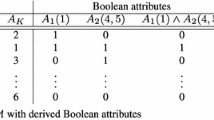Abstract
Data mining evolved as a collection of applicative problems and efficient solution algorithms relative to rather peculiar problems, all focused on the discovery of relevant information hidden in databases of huge dimensions. In particular, one of the most investigated topics is the discovery of association rules.
This work proposes a unifying model that enables a uniform description of the problem of discovering association rules. The model provides a SQL-like operator, named X⇒Y, which is capable of expressing all the problems presented so far in the literature concerning the mining of association rules. We demonstrate the expressive power of the new operator by means of several examples, some of which are classical, while some others are fully original and correspond to novel and unusual applications. We also present the operational semantics of the operator by means of an extended relational algebra.
Similar content being viewed by others
References
Agrawal, R., Faloutsos, C. and Swami, A. Efficient similarity search in sequence databases. In 4th International Conference On Foundations of Data Organization and Algorithms, Chicago, October 1993.
Agrawal, R., Ghosh, S., Imielinski, T., Iyer, B. and Swami, A. An interval classifier for database mining applications. In 18th International Conference on Very Large Databases (VLDB), pages 560–573, Vancouver, August 1992.
Agrawal, R., Imielinski, T. and Swami, A. Mining association rules between sets of items in large databases. In Proc. ACM SIGMOD Conference on Management of Data, pages 207–216, Washington, D.C., May 1993. British Columbia.
Agrawal, R., Lin, K.I., Sawhney, H.S. and Shim, K. Fast similarity search in the presence of noise, scaling, and translation in time-series databases. In Proceedings of the 21st VLDB Conference, Zurich, Switzerland, September 1995.
Agrawal, R., Mannila, H., Srikant, R., Toivonen, H. and Verkamo, A.I. Fast discovery of association rules. In Padhraic Smyth Usama M. Fayyad, G. Piatetsky-Shapiro and Ramasamy Uthurusamy (Eds), editors, Knowledge Discovery in Databases, volume 2. AAAI/MIT Press, Santiago, Chile, September 1995.
Agrawal, R., Psaila, G., Wimmers, E.L. and Zait, M. Querying shapes of histories. In Proceedings of the 21st VLDB Conference, Zurich, Switzerland, September 1995.
Agrawal, R. and Srikant, R. Fast algorithms for mining association rules in large databases. In Proceedings of the 20th VLDB Conference, Santiago, Chile, September 1994.
Agrawal, R. and Srikant, R. Mining sequential patterns. In International Conference on Data Engineering, Taipei, Taiwan, March 1995.
Atzeni, P. and De Antonellis, V. Relational Database Theory: A Comprehensive Introduction. Bejamin Cummings, 1993.
Faloutsos, C., Ranganathan, M. and Manolopoulos, Y. Fast subsequence matching in time-series databases. In Proc. of the ACM SIGMOD Conference on Management of Data, May 1994.
Gray, J., Bosworth, A., Layman, A. and Piranesh, H. Data cube: A relational aggregation operator generalizing group-by, cross-tab, and sub-totals. In ICDE96 12th International Conference on Data Engineering, pages 560–573, New Orleans, Louisiana, USA, February 1996.
Han, J. and Fu, Y. Discovery of multiple-level association rules from large databases. In Proceedings of the 21st VLDB Conference, Zurich, Switzerland, September 1995.
Houtsma, M.A.W. and Swami, A. Set-oriented mining for association rules in relational databases. In 11th International Conference on Data Engineering, Taipei, Taiwan, March 6-10 1995.
Houtsma, M.A.W. and Swami, A. Set-oriented mining in relational databases. Data and Knowledge Engineering, To Appear 1996.
Imielinski, T. and Mannila, H. A database perspective on knowledge discovery. Coomunications of the ACM, 39(11):58–64, November 1996.
Meo, R., Psaila, G. and Ceri, S. A tightly coupled architecture for data mining. In Proceedings of the IEEE International Conference on Data Engineering, Orlando, Florida, February, 1998.
Park, J.S., Shen, M. and Yu, P.S. An effective hash based algorithm for mining association rules. In Proceedings of the ACM-SIGMOD International Conference on the Management of Data, San Jose, California, May 1995.
Srikant, R. and Agrawal, R. Mining generalized association rules. In Proceedings of the 21st VLDB Conference, Zurich, Switzerland, September 1995.
Srikant, R. and Agrawal, R. Mining generalized association rules. Technical Report RJ 9963, IBM Almaden Research Center, San Jose, California, June 1995.
Ullman, J.D. Priciples of Database and Knowledge-Base Systems, volume 1 of Principles of Computer Science Series. Computer Science Press, Rockvill, Maryland (USA), 1988.
Weiss, S.M. and Kulikowski, C.A. Computer Systems that Learn: Classification and Prediction Methods from Statistics, Neural Nets, Machine Learning, and Expert Systems. Morgan-Kaufmann, 1991.
Author information
Authors and Affiliations
Rights and permissions
About this article
Cite this article
Meo, R., Psaila, G. & Ceri, S. An Extension to SQL for Mining Association Rules. Data Mining and Knowledge Discovery 2, 195–224 (1998). https://doi.org/10.1023/A:1009774406717
Issue Date:
DOI: https://doi.org/10.1023/A:1009774406717




